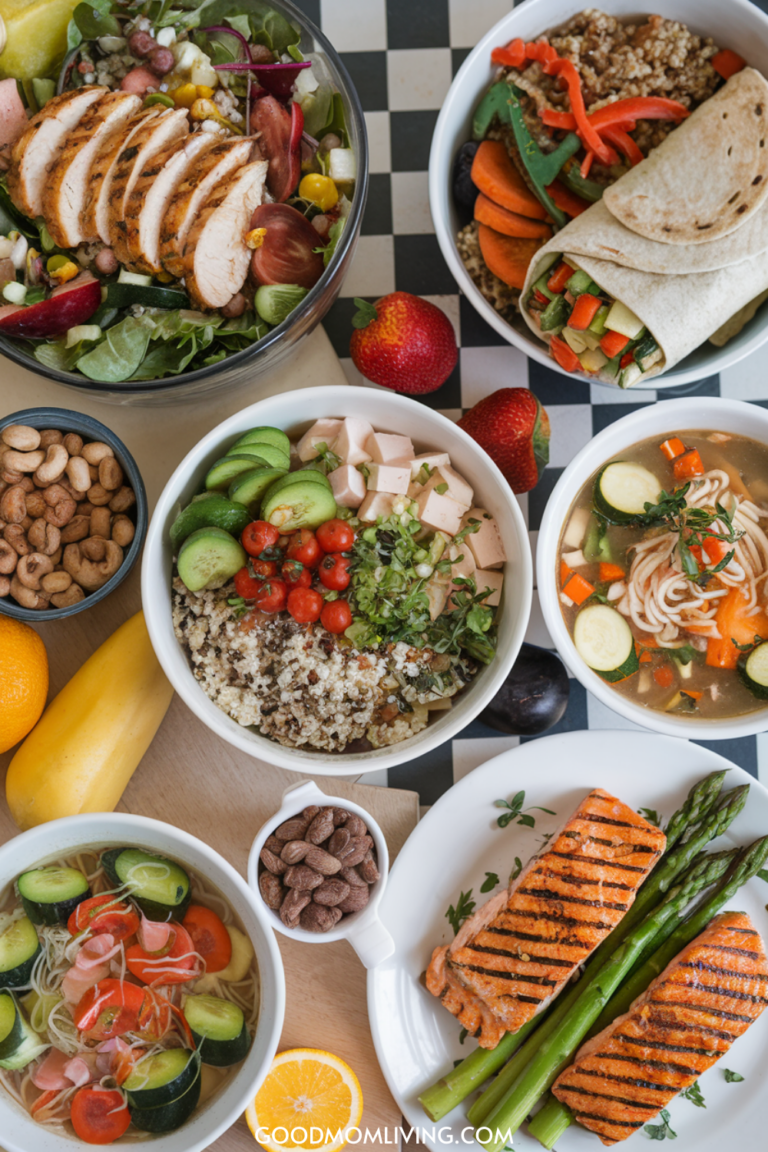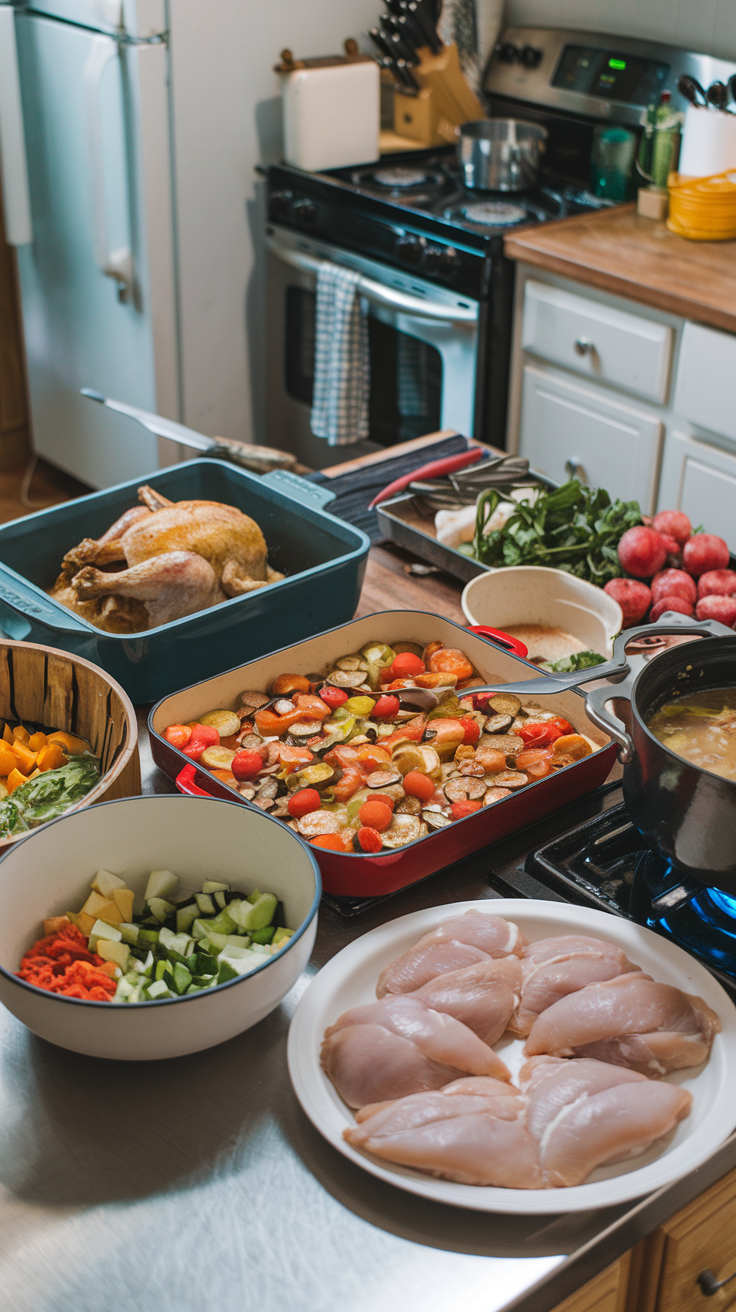This post may contain affiliate links. Read the full disclosure here.
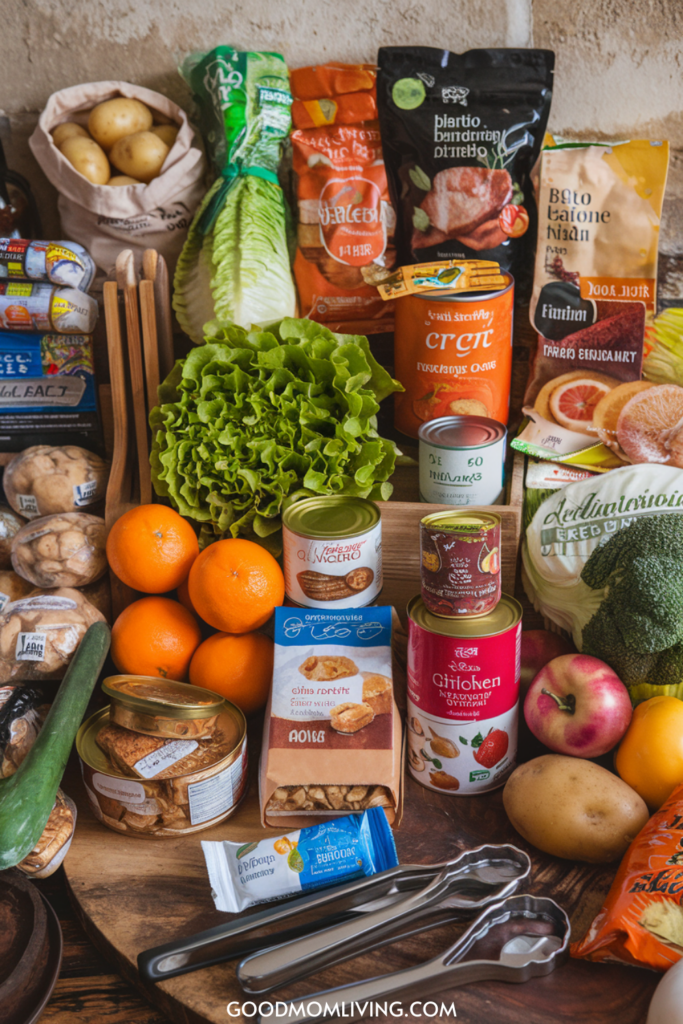
As a busy mom of three, I’ve felt the grocery bills creeping higher each week, swallowing up more of our budget than I’d like. Figuring out how to create a cheap weekly meal plan for families has been a gamechanger!
This healthy meals for a month menu is a great starting point if you’re tired of repeating the same meals but still want to keep things affordable.
For quick wins throughout the day, these easy snacks your kids will actually eat are lifesavers during busy afternoons and after-school chaos.
But I’ve learned a few tricks to keep our weekly meal costs in check without sacrificing quality or taste! Whether you’re juggling soccer games, piano lessons, or just trying to get everyone fed between work and bedtime, I know how valuable a plan can be.
In this post, I’ll share simple ways to save on groceries while crafting a cheap weekly meal plan for families, packed with delicious and budget-friendly meals!
And if you’re brand new to meal planning, this beginner-friendly guide to meal planning for moms breaks it all down into simple, stress-free steps.
Let’s explore how I can help you save money, reduce waste, and still serve meals your family will love!
- Don’t forget! Pin this post to Pinterest to read again later!
- Create a Budget for Groceries
- Plan Your Meals Ahead
- Make a Grocery List and Stick to It
- Utilize Sales and Coupons
- Buy in Bulk Smartly
- Shop Seasonal and Local Produce
- Cook from Scratch More Often
- Reduce Food Waste
- Get Creative with Snacks
- Conclusion
Don’t forget! Pin this post to Pinterest to read again later!
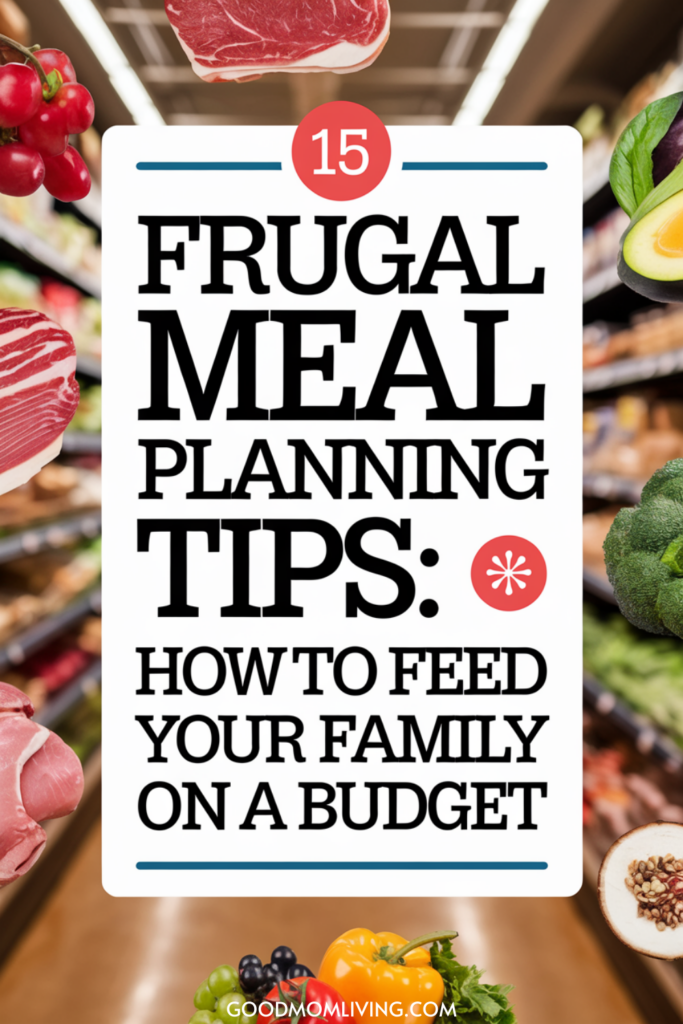
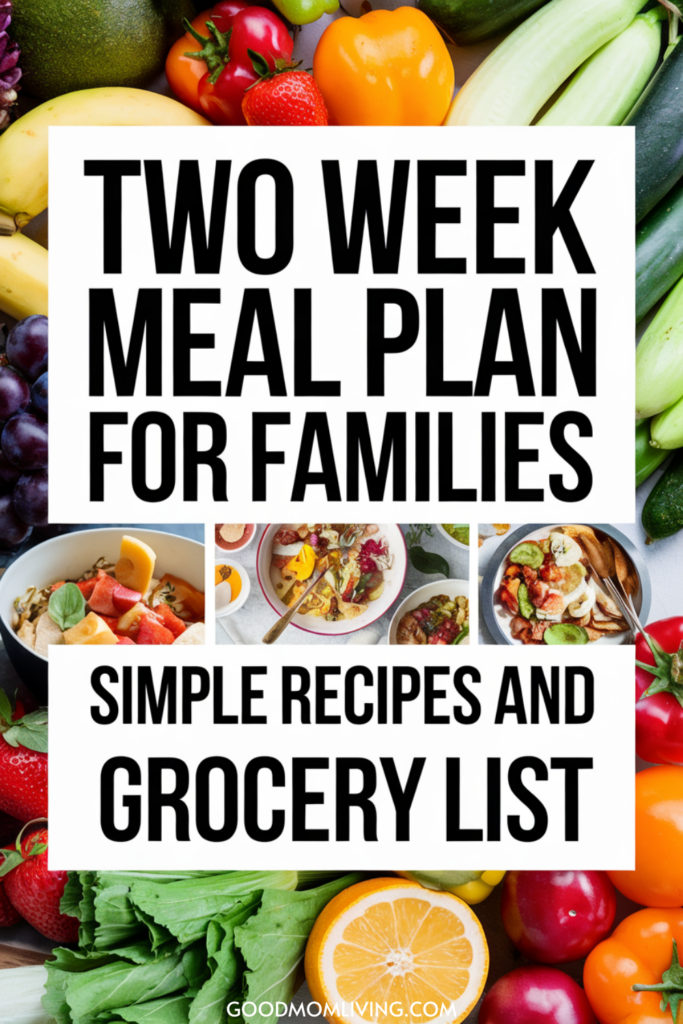

Create a Budget for Groceries
Balancing a weekly meal plan for your family while keeping costs under control can feel like a juggling act. But with the right approach, it’s easier than it seems.
Creating a grocery budget isn’t just about tightening the purse strings; it’s about empowering yourself with smart strategies that allow you to spend wisely and still whip up delicious, frugal meals everyone will look forward to.
Let’s explore practical steps to keep your grocery spending in check and perfect your cheap weekly meal plan for families.
Track Your Spending
One of the first steps in reigning in your grocery budget is knowing where your money goes.
Do you really know how much you’re spending each week on groceries? Keeping tabs on each purchase and tracking expenses is crucial.
Consider using a simple spreadsheet or a smartphone app to log your grocery costs.
Apps like Mint or EveryDollar offer intuitive interfaces that make tracking easy and even a bit fun. If you’re more old school, a notebook works just as well. The key is consistency. At the end of each week, glance over your list. This snapshot provides invaluable insight into patterns and helps identify areas where you can cut back, leading to significant savings over time.
Set Weekly Limits
Once you’ve got a handle on your grocery spending, setting a weekly limit becomes much easier and less daunting. Think of it like setting the boundaries on a coloring page; it gives you room to be creative without going overboard. But how do you find the sweet spot?
Start by reviewing your tracked expenses from the past few weeks. Identify the average you usually spend, then challenge yourself to cut it by a realistic percentage. If you spent $150 last week, aim for $135 this week.
Adjust these limits based on your family’s needs, but stick to the plan — even if it means swapping pricey steaks for budget-friendly meals like pasta or hearty soups. It’s all part of perfecting a balanced and cheap weekly meal plan for families.
Remember, small steps can lead to big savings. Setting and sticking to a grocery budget helps not only keep costs in check but also maximizes the money you spend on those cherished family dinners.
Plan Your Meals Ahead
Planning meals in advance might sound like a chore, but trust me, it’s a time-saving, money-saver strategy every busy mom needs to embrace. With a little foresight and creativity, you can craft a meal plan that caters to your family’s tastes, supports your budget, and keeps your week running smoothly. Let’s look at how you can make the most of planning your meals ahead of time.

Use a Cheap Weekly Meal Plan for Families
Building a meal plan that’s both cheap and family-friendly can be a fun puzzle to solve.
Start by laying out a weekly menu that includes nutritious options everyone loves. Here are a few tips to get you started:
- Select Base Ingredients: Opt for versatile ingredients like rice, pasta, and beans. These are cost-effective and can be transformed into different dishes with ease.
- Incorporate Seasonal Produce: Fresh produce can make meals healthier and more appealing. Seasonal fruits and veggies usually cost less and taste better.
- Rotate Recipes: Keep things interesting by rotating a few tried-and-true budget-friendly recipes each week. For instance, a simple stir fry, hearty soups, or pasta bakes are fantastic go-tos.
When you have this cheap weekly meal plan for families outlined, shopping becomes easier, faster, and less expensive. You know what you need and avoid the temptation of impulse buys that can skyrocket your grocery bill.
Incorporate Leftovers Wisely
Leftovers don’t have to be dull. They’re a golden opportunity to save bucks and reduce waste.
So how do you make leftovers exciting and new again?
- Creative Combinations: Use leftover chicken for tacos one night and a casserole the next. Or transform yesterday’s veggies into a nourishing frittata.
- Theme Nights: Dedicate a night or two a week to sandwiches or soups, using up those leftovers. They can be a canvas for any lingering ingredients in your fridge.
- Portion and Freeze: If you know a dish will make plenty, freeze half for a ready-to-go meal another week. This makes life easier when you’re short on time and ideas.
By making leftovers a part of your cheap meal plan, you not only cut down on waste but also on the time spent cooking each night. It’s a win-win scenario perfect for those hectic weeknights when you feel stretched thin.
Make a Grocery List and Stick to It
When you’re managing a family and aiming to save money, sticking to a grocery list is your secret weapon.
It’s like having a map for your grocery adventure—keeping you on track, on budget, and away from those alluring but unnecessary aisle distractions. Here’s how you can make this strategy work wonders for your weekly meal plan.
Organizing the List by Sections
Have you ever found yourself wandering back and forth through the grocery store because you forgot something in the produce section when you’re already in dairy?
Yeah, I’ve been there too!
That’s why organizing your grocery list by store sections is a game-changer.
Think of it as planning a route for a road trip. You wouldn’t backtrack to check out a scenic spot you passed miles ago, right? Group items like produce, bakery goods, and canned products together.
Not only does this save precious time, but it also helps you stay focused. You breeze through the store in record time, reducing the temptation to grab non-essentials that catch your eye.
Add Only Essentials to the List
Let’s talk about impulse buying—the nemesis of every budget-conscious family. The secret to sticking to your budget? Add only essentials to your list.
Before heading out the door, gather your family’s meal preferences and jot down everything you’ll need for your cheap weekly meal plan. Here’s a tip: make your list after meal planning. This way, you know exactly what you need to turn those recipe ideas into reality.
Whenever you’re tempted to toss a candy bar or that extra bag of chips into the cart, ask yourself: “Is this on the list?” If it’s not on your carefully curated list, it likely isn’t necessary.
Remember, those small, unnecessary splurges can add up, throwing your budget out the window. Prioritizing essentials helps resist impulse buys, keeping your spending in line with your financial goals.
Using these approaches in your family meal planning ideas ensures a smoother and more budget-friendly shopping experience. It’s all about sticking to the essentials and making your trips efficient and effective.

Utilize Sales and Coupons
When it comes to saving money on groceries, sales and coupons are your best allies. For busy families juggling countless responsibilities, these tools can make a huge difference.
Who doesn’t love the thrill of snagging a deal that leaves your wallet a little fuller?
Here are a couple of practical ways to get started on your savings journey, so you can focus more on what truly matters.
Sign Up for Store Loyalty Programs
Let’s start with a simple yet often overlooked hack: store loyalty programs. Think of these as your backstage pass to savings.
By joining local grocery store loyalty programs, you open the door to exclusive discounts, special promotions, and member-only prices. It’s like having a golden ticket for your family’s grocery needs.
Not only do these programs usually offer points for every dollar you spend, which can later translate into discounts, but they often include digital coupons tailored to your shopping habits.
Sign-ups are usually free and take just a few clicks. Next time you’re shopping, let each scan of your loyalty card feel like a mini victory, knowing you’re chipping away at your grocery bill.
Use Coupon Apps
In the age of smartphones, couponing is no longer the tedious chore it once was. Enter coupon apps—your pocket-sized budget savers!
These apps are designed to help you find the best deals on the items you love. Imagine having a personal shopping assistant with you wherever you go.
Popular apps like Honey, Rakuten, and Ibotta are favorites among savvy moms. These apps offer cash-back rewards and notify you of available discounts. Simply browse for coupons before you shop, and watch the savings accumulate. It’s like finding money in your pocket you didn’t know was there!
Go ahead, download a couple of these handy tools, and start stacking those savings. Who knew saving money could be so… well, rewarding?
Buy in Bulk Smartly
When you’re running a busy household, buying in bulk can be a magical way to save money. But it takes a bit of savvy to make it work without ending up with a bunch of things you don’t need.
Let’s explore how you can maximize your savings and keep your pantry stocked with essentials your family loves.
Join a Bulk Buying Club
Have you ever driven past a wholesale store and wondered if it’s worth the membership fee? Let me tell you—joining a bulk buying club can seriously cut down on your grocery costs.
These clubs offer access to bulk-sized products that usually come with significant discounts. Picture buying the snacks your kids love, not by the box, but by the case!
By splitting membership costs and purchases with friends or family, you can enjoy great savings together. This way, you’re not only reducing costs but also building a small community where everyone benefits. It’s like having your own savings team!
Whether it’s paper towels or pasta, you’ll find a bulk buying club makes stocking up feel less like a chore and more like a win for your budget-friendly meal planning.
Storage Tips for Bulk Purchases

So, you’ve bought all these goodies at a discount. Now, the trick is keeping everything fresh and organized—because, let’s face it, nobody wants double the discount with double the waste. Here are some storage hacks that I’m sure will help you stretch those bulk buys further:
Use Clear Storage Bins: Keep an eye on your inventory without opening every container. Clear bins are a lifesaver for swiftly locating that one last bag of rice you knew you had somewhere.
Label Everything: Dates and contents are key. A simple label maker or even a sharpie can save you the headache of playing the guessing game with expiration dates.
Freeze Wisely: Did you know many dry goods and even meats can be frozen to prolong their shelf life? Seal properly in airtight bags to prevent freezer burn and keep those flavors locked in.
Rotate Your Stock: Organize older items at the front and newly purchased ones at the back. Think of it like you’re working the shelves at your own grocery store. This method ensures nothing goes to waste and keeps your meal planning ideas fresh.
With these strategies, buying in bulk becomes a smooth part of your grocery routine, not only helping you stock up but also contributing to a frugal meal plan the whole family will appreciate.
There’s nothing quite like the satisfaction of knowing you’re serving low-budget meals your family loves without breaking a sweat—or the bank!
Shop Seasonal and Local Produce
Saving money on groceries without sacrificing quality is a goal many families strive for. One of the simplest ways to cut costs and boost flavor in your meals is by making the most of seasonal and local produce.
Why pay more for out-of-season fruits and veggies when you can buy what’s fresh and abundant? Let’s explore how you can take advantage of the bounty offered by local farmers and turn it into budget-friendly meals that your family will love.
Visit Local Farmers’ Markets
Visiting farmers’ markets is like stepping into a world of fresh, vibrant produce waiting to be discovered. If you haven’t already, I highly encourage you to take your kids for a family outing to a nearby market. It’s a great way to support local farmers and often means snagging fresh produce at lower prices than supermarkets. Why spend more when you can get quality straight from the source?
Picture this: rows of colorful stalls filled with freshly picked fruits and vegetables, just begging to be part of your next meal plan.
You not only buy fresh and tasty food but also help local agriculture thrive, which is a win-win.
Plus, many farmers are happy to share cooking tips and storage secrets. This can be invaluable when planning your weekly menu around seasonal availability. Who knew saving money could be such a feast for the senses?
Get Kids Involved in Choosing Produce
Let’s face it—getting kids to enjoy healthy foods can sometimes feel like a game of tug-of-war. But what if you included them in the decision-making process? Bringing your kids along to choose fruits and veggies can transform grocery shopping from a chore into an adventure.
It’s a bit like letting them roam a treasure trove where every find is a chance to learn.
Allowing them to pick, touch, and even taste different produce can spark curiosity and make them more excited about eating what they’ve helped choose.
You could even make it a game: “Who can find the reddest apple?” or “Let’s pick tonight’s veggies together!” It empowers kids and makes them more likely to eat and appreciate fresh foods.
Plus, it can teach them valuable lessons about healthy eating habits right from the get-go.
By integrating these visits and activities into your routine, you’re not just checking off a task from a list. You’re creating memories, involving your family in meal prep, and laying the groundwork for lifelong healthy eating habits. You’re also keeping your grocery bill in check, which means more room in the budget for those unforgettable family experiences outside the kitchen.
Cook from Scratch More Often

Cooking from scratch not only nourishes our bodies but also keeps our wallets happy. As a busy mom, I’ve come to appreciate the value of whipping up meals at home. When we know exactly what goes into our food, it’s naturally healthier and often cheaper.
Plus, nothing beats the aroma of a home-cooked meal that fills the kitchen with warmth and love. Here’s how we can make this a practical, sustainable habit, even with our packed schedules.
Simple and Quick Recipes
Who says cooking from scratch has to be complicated? I’ve found several go-to recipes that are both fast and satisfying. Here are a few family favorites:
- Stir-Fry Extravaganza: This is a lifesaver on hectic evenings. Grab some rice or noodles, toss in whatever veggies you have (like bell peppers, broccoli, and snap peas), add a protein like chicken or tofu, and finish with a splash of soy sauce or teriyaki. Ready in under 30 minutes!
- Hearty Chili: With canned beans, tomatoes, corn, and ground beef or turkey, this chili is a one-pot wonder. Spice it up with chili powder and cumin, simmer, and serve with crusty bread. It’s perfect for those chilly nights.
- Pasta Primavera: Cook your favorite pasta, sauté some vegetables such as zucchini, carrots, and bell peppers, and mix with olive oil, garlic, and parmesan cheese. It’s both colorful and nutrient-packed.
These dishes are ideal for when you need to prepare dinner quickly yet don’t want to compromise on flavor or nutrition. They prove that eating well can be cost-effective and stress-free.
Batch Cooking for Busy Weeks
Batch cooking is a game changer when it comes to managing time and money. It’s like putting your kitchen on autopilot.
Spend some time on the weekend preparing multiple meals that can easily be reheated during the week. This means fewer late-night fast food runs and more consistent savings on your grocery bill.
- Cook Once, Eat Twice (or More!): Think about dishes like lasagna, casseroles, and soups that get better as they sit. Make a big pot or pan, and portion into containers for the coming days.
- Freeze for Future Ease: Have a variety of freezer-friendly meals ready to go. Whether it’s a batch of stew, homemade marinara sauce, or enchiladas, freezing portions ensures you always have something prepped.
- Double the Recipe: Whenever you’re making something like meatballs or pancakes, prepare extra to freeze. Having these staples stashed away will come in handy on those nights when life gets chaotic.
By incorporating batch cooking into your routine, you’ll save time on meal prep during the week, helping you avoid costly takeaway options. Not only does this method align with a cheap weekly meal plan for families, but it also keeps everyone well-fed without breaking the bank.
Reduce Food Waste
Reducing food waste is not only a fantastic way to save money on groceries but also an opportunity to be a little kinder to our planet.
As families, our days are busy, and often leftovers get overlooked or produce goes bad before you know it.
Let’s dive into practical steps that can help us make the most of what we’ve got!
Check Expiry Dates Regularly
I can’t count how many times I’ve found an expired item hidden at the back of the pantry. We’ve all been there, right? Regularly checking expiry dates is like doing a quick inventory of your treasures—guarding them against slipping into the forgotten zone.
Here’s a simple method: once a week, take a few minutes to scan your pantry and fridge. Move items close to their expiry to the front, so they’re more likely to be used before anything else.
It’s like setting up a priority queue—but for your food! And don’t forget the freezer; even frozen goods have a lifespan. By staying on top of expiry dates, you not only keep things fresh but also prevent the sad fate of tossing what could have been tonight’s dinner. It’s a small habit with a big payoff—less waste and more savings!
Compost What You Can’t Use
Sometimes, veggies wilt, fruits soften, or meals just aren’t finished. Rather than seeing these as waste, think of them as future plant food. Composting is an eco-friendly way to return nutrients to the earth and keep food scraps from heading to the landfill.
Starting a compost pile doesn’t need to be complicated. Even if you live in an apartment, options like small indoor compost bins are available.
What’s great is getting kids involved in this process—it’s hands-on learning about sustainability. Watching scraps transform into rich soil can be fascinating, much like witnessing magic happen in your own backyard.
Imagine turning yesterday’s salad remnants or fruit peels into the nutritious soil that helps grow tomorrow’s lush garden. It’s a cycle of renewal that’s both responsible and rewarding. Save money on fertilizers, reduce waste, and feel good about your contribution to a greener world, all by composting.
Reducing food waste isn’t about perfection—it’s about making intentional choices that benefit both home and planet. By regularly checking those expiry dates and composting what you can’t use, you’re on your way to less waste and more efficient grocery spending. It’s a journey that’s easier than you might think, with benefits that ripple out beyond your kitchen.
Get Creative with Snacks
Snacks are more than just fillers between meals—they’re opportunities for fun, creativity, and savings! Busy families can keep bellies full and budgets intact by crafting their own snacks. Here’s how we can transform snack time from a budget-draining experience into a money-savvy delight.
DIY Snack Ideas
Who needs store-bought snacks with all those unnecessary additives and costs?
Making snacks at home is not only healthier but also cheaper. Here are some easy and fun homemade snack ideas that will excite your taste buds and keep your wallet happy:
- Trail Mix Creation: Start with a base of nuts or seeds, add dried fruit, toss in a handful of cereal, and sprinkle with chocolate chips. Let everyone customize their mix!
- Homemade Granola Bars: Use oats, honey, and your favorite nuts. They’re simple to bake, and you can wrap them individually for quick grabs on your way to soccer practice.
- Veggie Chips: Slice up sweet potatoes, beets, or even kale, season them, and bake until crispy. They’re a crunchy delight without the chip price tag.
- Fruit Popsicles: Blend fruit with yogurt, pour into molds, and freeze. They’re a refreshing treat that tastes like summer in every bite.
Crafting snacks like these means you’re always ready with tasty options that don’t break the bank.
Involve Kids in Snack Prep
Why not turn snack prep into a family activity? Getting kids involved is a fantastic way to teach them about nutrition and develop a lifelong appreciation for homemade food. Plus, it makes snack time something they helped create—making them more likely to eat it!
Here’s how you can get started:
- Mini Chefs: Assign simple tasks like washing fruits or stirring mixtures. It’s empowering for kids and gives them a sense of pride in what they’ve made.
- Snack Assembly Line: Turn snack-making into a play session. Set up stations for different toppings and let kids build their own snacks.
- Taste Testers: Encourage kids to try new ingredients while prepping to broaden their palate and reduce fussiness.
These activities not only foster teamwork but also sneak in some crafty lessons about healthy eating.
Snacks become a source of joy and togetherness rather than just something to munch on.
Plus, when kids are involved in making food, they’re more excited to eat the results, leading to smiles all around at snack time.
Conclusion
Saving money on groceries doesn’t have to be a headache. With a cheap weekly meal plan for families, we can enjoy delicious and budget-friendly meals that keep everyone happy. By setting a clear grocery budget, planning our meals, sticking to a list, and embracing sales and coupons, we’re already on the path to success.
Involve the kids in shopping and cooking. It’s a great way to teach them about healthy eating and make mealtime fun. Cooking from scratch? A lifesaver for the taste buds and the wallet! Plus, don’t forget the power of leftovers—they’re a game changer for reducing waste and stretching meals.
Time to take the plunge, moms! Start saving money on groceries today and watch your budget breathe a sigh of relief. What are you waiting for? Let’s make those savings happen and create incredible meals your family will love. What are your favorite budget-friendly meal planning tips? Share your thoughts and let’s keep the conversation going!




